Michigan’s Falling Waters Trail
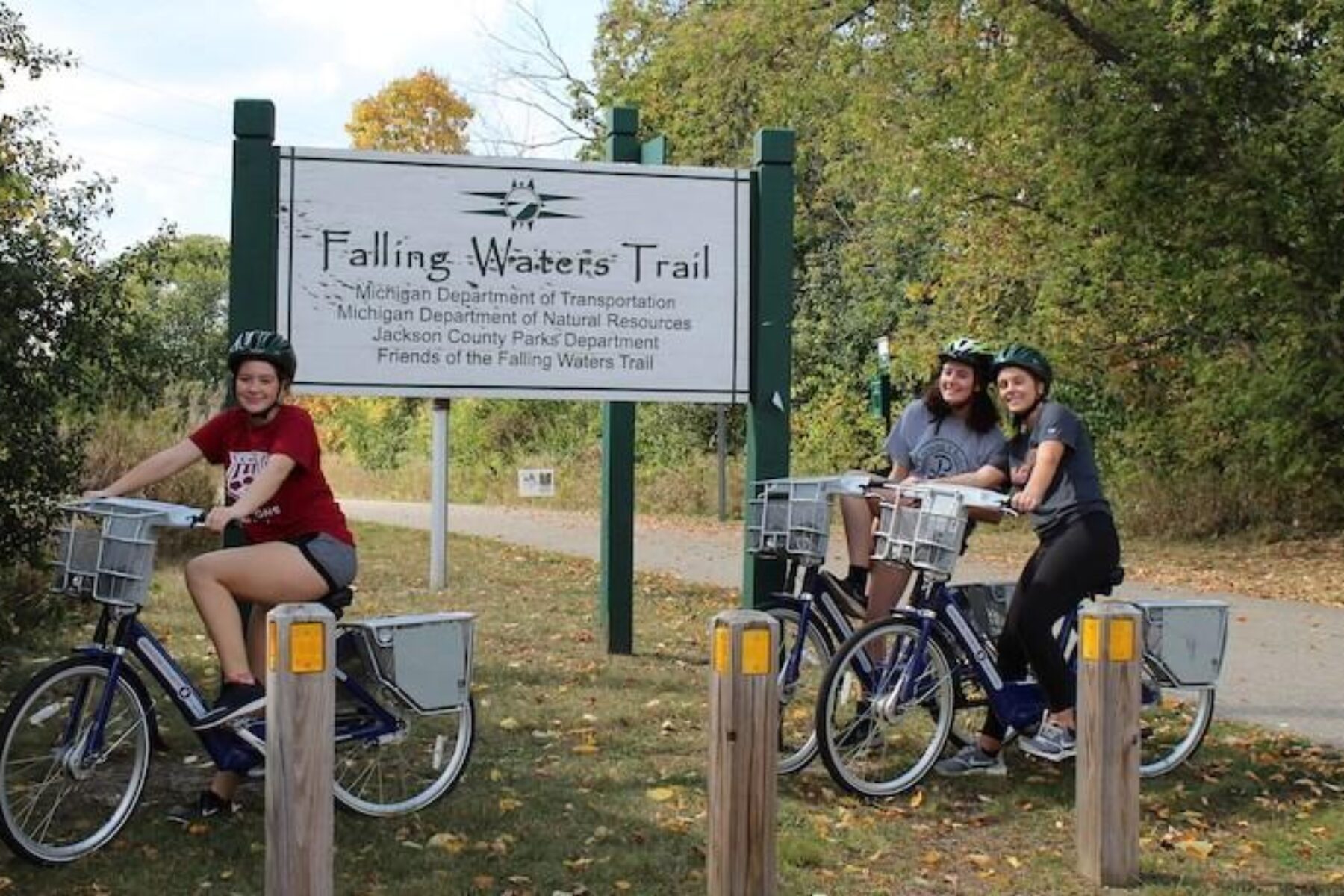
Trail of the Month: September 2019
“Throughout the week, there are always people out using it.”
—Kyle Lewis, trail manager for Jackson County Parks
Michigan’s Falling Waters Trail serves as a beloved community connector, linking the outskirts of the vibrant City of Jackson to the picturesque Village of Concord, which brims with Victorian homes. Though this destination rail-trail is on the shorter side at 10.5 miles, it’s onto something big. Actually, two really big things: it’s nestled within the Great Lake-to-Lake Trail route spanning the entire Lower Peninsula from Lake Michigan to Lake Huron, as well as the even more massive Iron Belle Trail, which connects 2,000-plus miles of trail all across the state.
“It’s one of our most popular and widely used county parks,” noted Kyle Lewis, who manages the trail for Jackson County Parks. “The trailhead parking lots are usually full on weekends. Even throughout the week, there are always people out using it.”
Jeremiah Bush, Concord’s Village President and a regular trail rider, notes that local restaurants have commented on the uptick in business that the trail brings. His community has fully embraced the pathway, ushering improvements to Concord’s section—such as bike racks, picnic areas and a boat launch—to encourage more visitors.
Falling in (Trail) Love
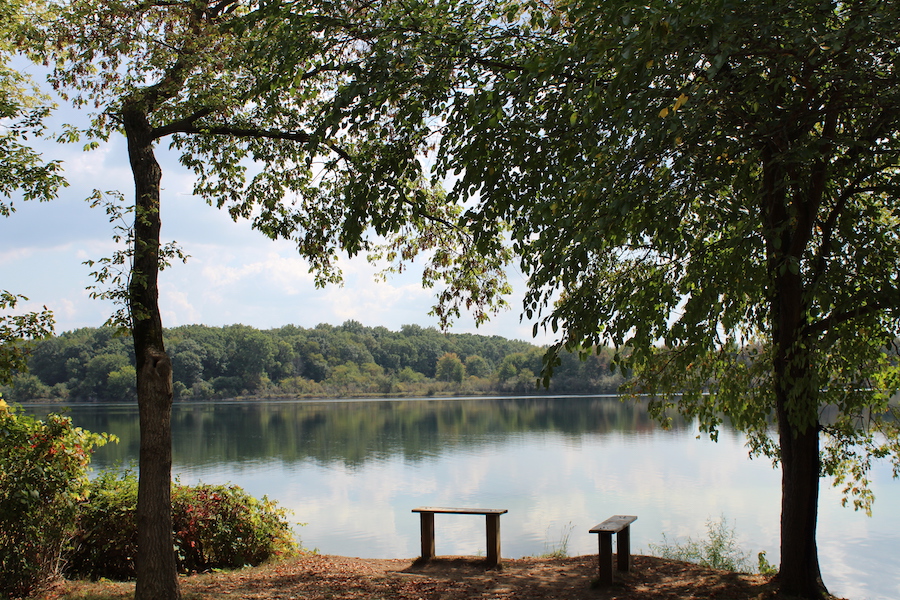
The trail’s value as a transportation corridor goes back to its days as a Michigan Central Railroad route. The railroad was completed in 1871 and the tracks remained in use for more than a century. In Jackson, you can find one of the old passenger depots still serving its original function; the beautiful red brick building, listed on the National Register of Historic Places, accommodates Amtrak trains today.
“An Amtrak rail line parallels most of our trail, from Kalamazoo to Port Huron,” said Bob Wilson, the executive director for Michigan Trails and Greenways Alliance, about the Great Lake-to-Lakes Trail Route #1. “That makes it easy to ride the trail and then hop on the train to ride back.”
Falling Waters Trail users can travel toward Jackson (originally named “Jacksonopolis” after President Andrew Jackson) on a connecting 3.4-mile rail-trail made from the same Michigan Central railbed: the Martin Luther King Equality Trail. At their juncture at Weatherwax Drive, a B-Cycle bike-sharing station offers an easy and relatively cheap way to grab a set of wheels for exploring either trail. For those making the longer trek across the state, a pleasant campground is available about 2 miles south of the trail’s Concord end at Swains Lake County Park.
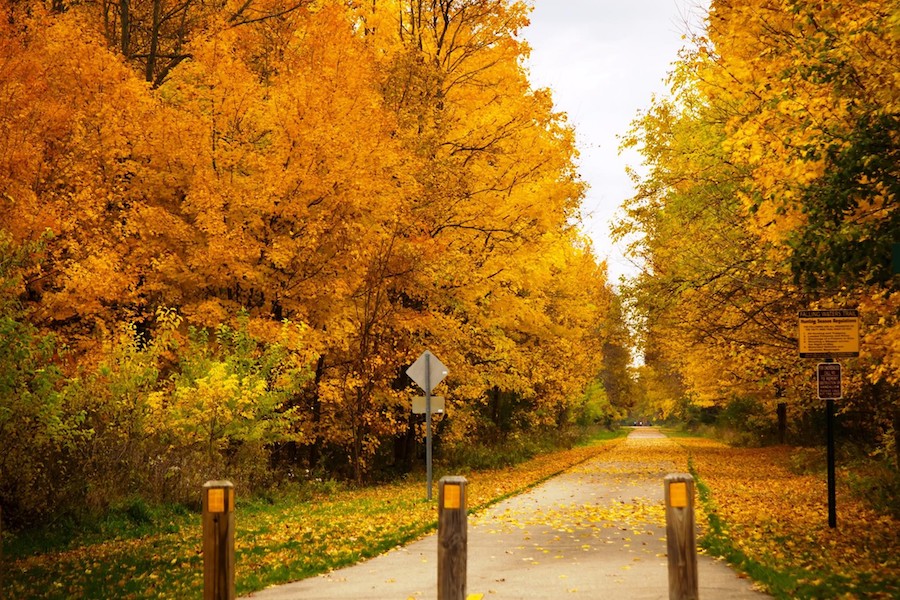
This time of year, the Falling Waters Trail is especially delightful; rolling through rural countryside and lush woodlands, the landscape is ablaze with fiery colors in the autumn. On its west end, the paved pathway crosses a branch of the Kalamazoo River and travels over wetlands teeming with birds and wildlife.
The trail even takes its name from the natural beauty that abounds here; the region’s Potawatomi tribes called the area “The Land of Falling Waters” for its numerous springs, lakes and rivers. Travelers can learn about the Potawatomi at a preserved village site near present-day Spring Arbor; the Falling Waters Historic Park is located just a half-mile north of the trail near the intersection of Cross and Hammond roads. Pedaling along, history buffs will also enjoy the numerous interpretative signs about the area’s past that dot the trail.
Another of the trail’s best features is actually a manmade lake that was formed from an early 20th-century mining site; about halfway along the pathway, adventurers will glide right through the middle of Lime Lake with a glistening expanse of water on both sides.
Falling Into Place
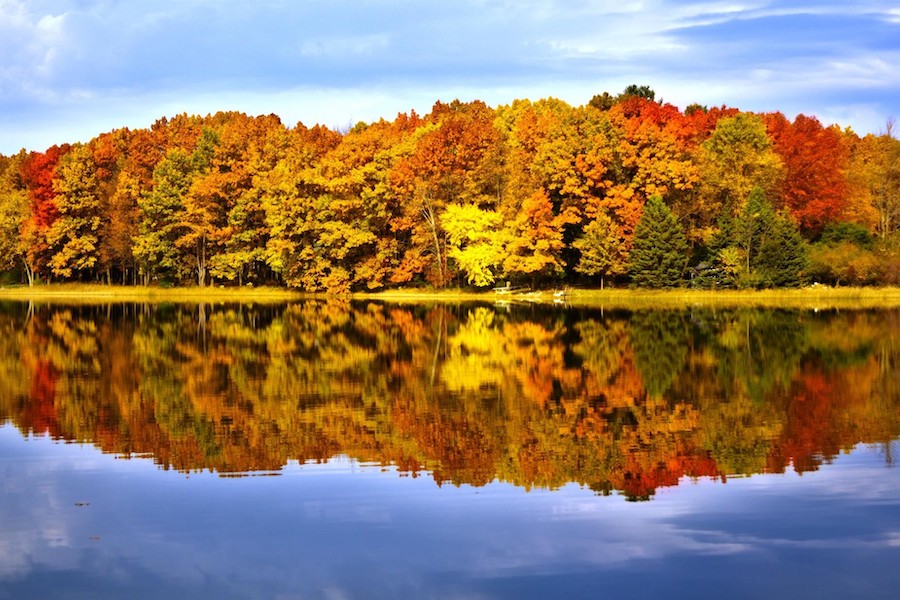
With its spectacular scenery and rich connections to history, the Falling Waters Trail, which first opened in 2007, has proved popular. Building on the success of this and other trails in the region, a new nonmotorized transportation plan is currently in the works to develop more opportunities for walking and biking in the city and county of Jackson. Community input on the plan is being gathered at several public meetings this month and the plan is expected to be finalized early next year.
“We passed a millage increase last summer, so with how that vote landed—and through feedback from the public and through surveys—it’s clear that trails are a huge priority for the community and something that people would like to see more of,” said Lewis, referring to the proposed property tax increase to support county parks. The measure, which received a nearly 59% approval rating from residents, is estimated to bring in $2.18 million annually for the next 10 years to improve and expand recreational amenities like the Falling Waters Trail.
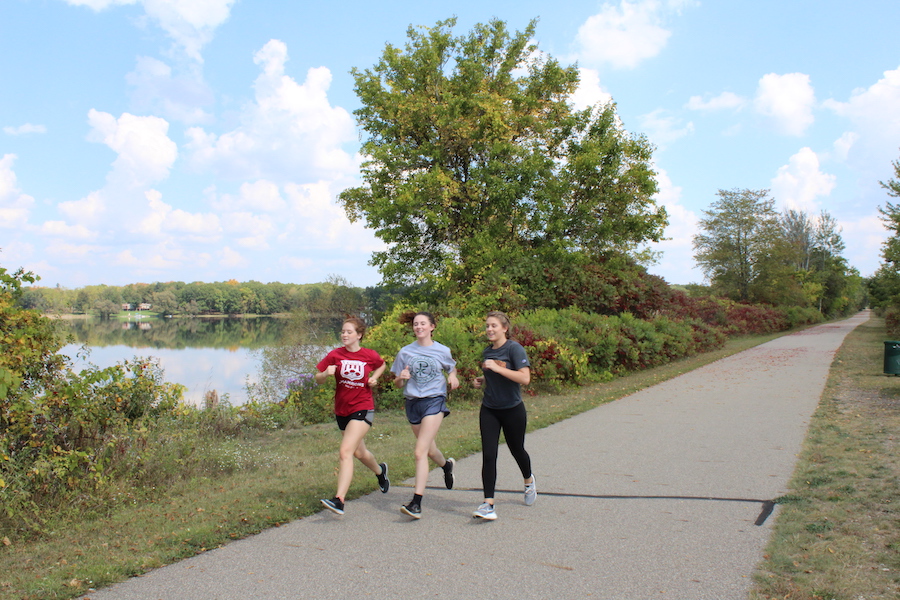
Another exciting trail development this year was the announcement of the inaugural group bike ride across the 275-mile expanse of the Great Lake-to-Lake Trails network’s Route #1. There are five numbered routes in the trail system and this one, which incorporates the Falling Waters Trail—as well as more than a dozen other rail-trails—will be celebrated by the 150 participants of the multiday ride taking place Sept. 13-18.
“Jackson County is right in the center of the state, so we’re in the center of this statewide trail network,” said Lewis, who noted that there are active plans for the Falling Waters Trail to expand from both its ends to connect to neighboring trails and allow riders to completely traverse the county by trail. “It’s widely used now by community members, but this will make the Falling Waters Trail a more regional destination, increasing tourism and bringing people here that are looking to do a great long-distance ride.”
Related Links
Trail Facts
Name: Falling Waters Trail
Used railroad corridor: Michigan Central Railroad
Trail website: Jackson County Parks
Length: 10.5 miles
County: Jackson
Start point/end point: Martin Luther King Equality Trail at Park Road (Jackson) and River Street, just east of Coxon Road (Concord)
Surface type: Asphalt
Grade: The Falling Waters Trail has the typical flat grade of a rail-trail.
Uses: Walking, bicycling and inline skating; wheelchair accessible; fishing is also available along the trail in Lime Lake County Park (5501 Teft Road, Spring Arbor Township)
Difficulty: With a smooth, level and paved surface, the Falling Waters Trail is suitable for all abilities.
Getting there: Visitors can arrive to the heart of Jackson via train at the city’s Amtrak station (501 E. Michigan Ave.); the beautiful red brick building, constructed in 1873, is on the National Register of Historic Places. The Martin Luther King Equality Trail begins a short distance from the station and connects to the Falling Waters Trail on the southwestern outskirts of the city.
If flying, travelers have a couple of options; the nearest commercial airports are about an hour’s drive from Jackson: Detroit Metropolitan Wayne County Airport (Detroit), Kalamazoo/Battle Creek International Airport (Kalamazoo), Capital Region International Airport (Lansing) and Toledo Express Airport (Toledo, Ohio).
Access and parking: Parking is available at the following locations along the trail from east to west:
- Weatherwax Trailhead at Weatherwax Drive and Park Road on the outskirts of Jackson
- Lime Lake County Park (5501 Teft Road, Spring Arbor)
- Concord Trailhead at the end of River Road, just east of Coxon St.
To navigate the area with an interactive GIS map, and to see more photos, user reviews and ratings, plus loads of other trip-planning information, visit TrailLink.com, RTC’s free trail-finder website.
Rentals: Near the east end of the Falling Waters Trail, travelers can pick up a bike at the Jackson County B-Cycle station (3720 Weatherwax Dr., Jackson); purchase a pass at the kiosk: $6 for 3 hours ($2/hour for each additional hour).

Donate
Everyone deserves access to safe ways to walk, bike, and be active outdoors.
